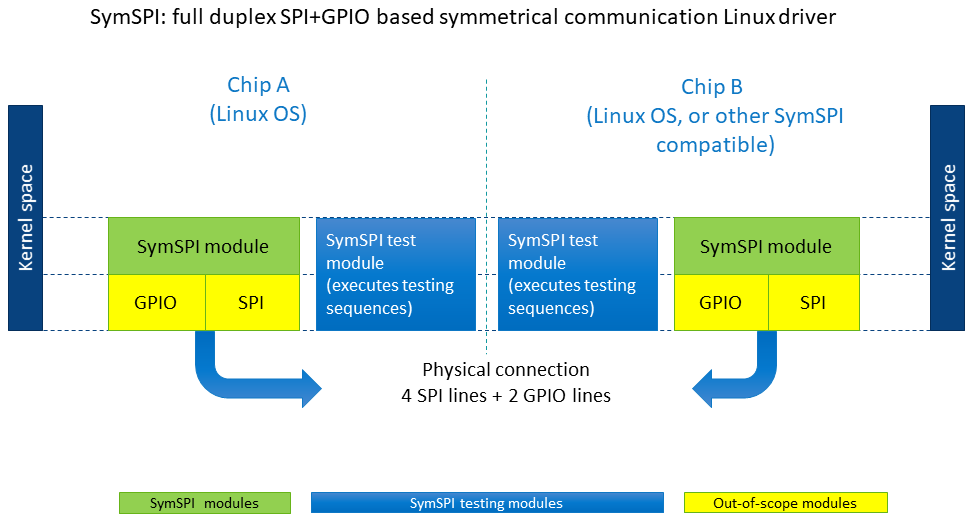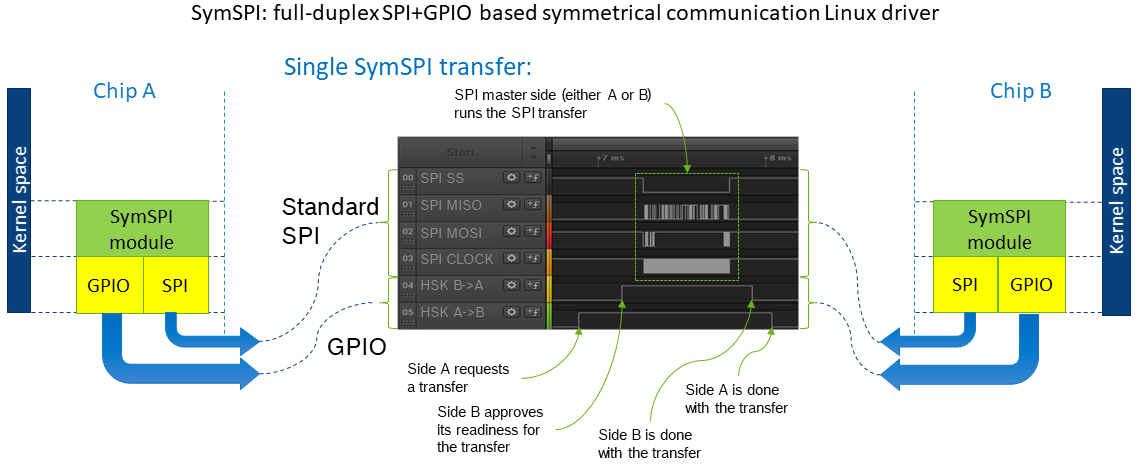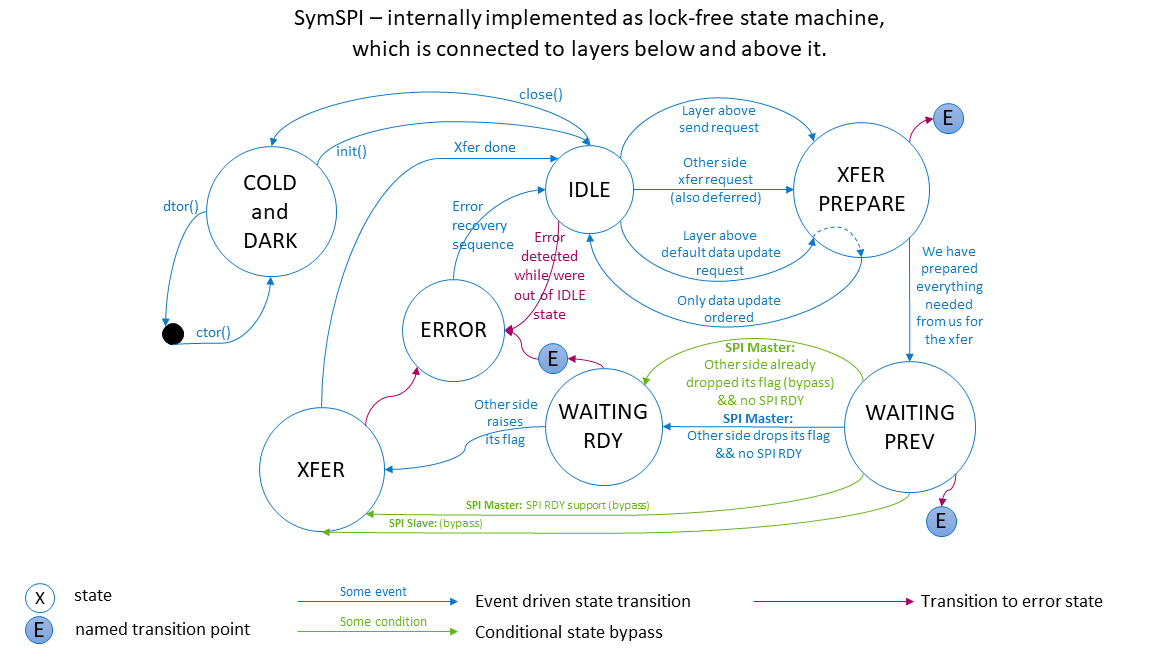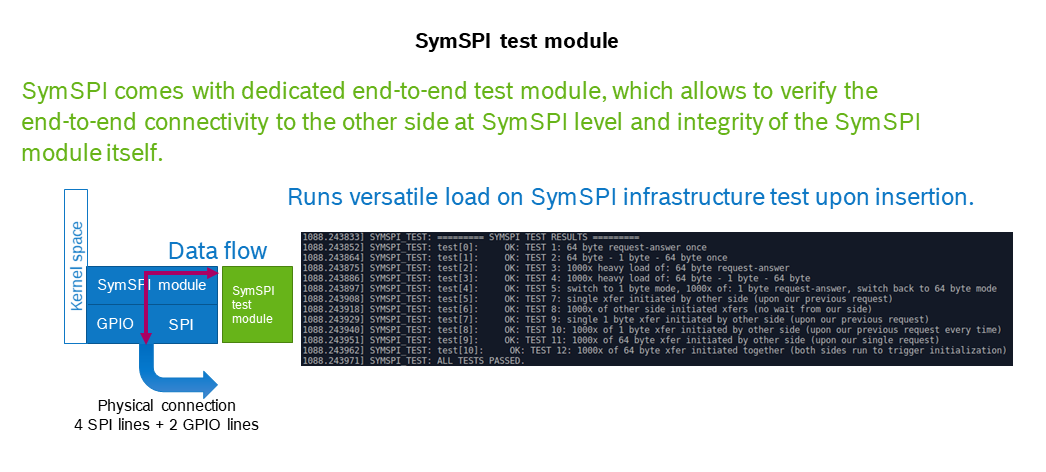SymSPI is a Linux data transport driver, whish provides symmetrical full-duplex communication between two chips using SPI bus and two GPIO flag lines.
Symmetrical is in sence that either of two communication sides can trigger the bi-directional data tranfer over SymSPI no matter which SPI role it plays.
Here it is a very complicated =) graph of location of the SymSPI module within the kernel:
SymSPI is aimed to provide a data transport between two active parties (both can send and request data on their own).
Such use case can occur when a device has, say, two active chips both running Linux OS(or compatible). One of them runs safety critical part of software and the other runs the rest of services, which still need to communicate with the safe domain. In this case SymSPI can naturally be used as a basis for symmetrical communication between first and second chip/OS.
SymSPI is light-weight so its counterparts can be implemented also on other memory-restricted realtime OSes (say, like Autosar OS implementation).
SymSPI has a relatively low latency - one can estimate that from transfer request till transfer start not more than 500us usually pass (mainline kernel estimation).
Let's take two chips which both play active role in a device, and both run Linux OS. Now, let's assume that both communication sides need actively initiate the data exchange with the other side (it can be event sending from side A to side B, and commands sending from B to A, etc.).
Then one either need to poll a passive SPI side from active SPI side (which is not really a graceful solution under most use cases when data flow is not really high), or to implement some facility on the GPIO basis which will allow passive SPI side to ask SPI active side to initiate data transfer.
SymSPI is the solution to this situation: any side will trigger a
data exchange transfer by calling symspi_data_xchange(...) routine
and then just wait for "transfer done" callback.
SymSPI uses
- 2 unidirectional GPIO lines (one from every side) as status/request indication lines (flag lines).
- Standard SPI bus (4+ lines) to run the data exchange itself.
A side asserts its flag line when it wants to initiate the data transfer or approve the initiate request from the other side.
A side de-asserts its flag line when it is done with current SPI transfer and ready for the next one.
Flag remains asserted from data transfer request/response till the time when a side is done with current transfer and ready for the next one.
A minimal flag down time T_down is configurable due to requirements
of the circuity and counterpart hardware.
If a side detects some error condition (like: unexpected transfer size, unexpected flag line change, error indication from the other side, buffer allocation failure, etc), then it triggers following flag line sequence:
- de-assert, wait
T_downus - assert, wait
T_downus - de-assert, wait
T_downus - assert, wait
T_downus - de-assert, wait
T_downus
and then goes into error state for configurable time T_error
in which there is no reaction on any external signals.
After T_error time passed normal communication flow is reestablished.
OK, it is probably better to look once instead of reading, here it is (the normal, non-faulty SymSPI transfer is shown):
Here it the short diagram of internal SymSPI states with corresponding transitions between them:
SymSPI provides the following calls to the upper layer (for detailed information see the documentation in/and code):
symspi_data_xchange(...)triggers the data exchange with the other side.symspi_default_data_update(...)updates the default data from our side.symspi_init()module init.symspi_close(...)stop the symspi and free all related resources.symspi_is_running(...)returns if SymSPI is running (not in Cold-and-Dark state).symspi_reset()resets the SymSPI to Idle state.symspi_iface()provides the full-duplex-symmetrical interface from SymSPI.
SymSPI is not a high-bandwidth transport, its performance is enough to serve as dbus analog between two chips: send messages, notifications, events, small amounts of data (of some KB size), or stream bigger data chunks when there is no time restriction (streaming some tens of MBs of data within some minutes).
SymSPI itself is not a guaranteed delivery transport, any distortions can appear on the SPI bus and it is responsibility of upper layer to fix it (see, for example, ICCom protocol Linux driver).
SymSPI comes with dedicated testing module, which carries out the SymSPI test upon insertion of the test module in the kernel and prints the test results to the kernel buffer.
The test example is shown below:
The test module runs a set of predefined transfers with the othe side and verifies the answers. This allows one to test both SymSPI module itself and the actual hardware connection between the chips.



